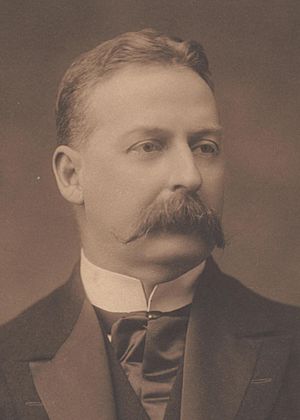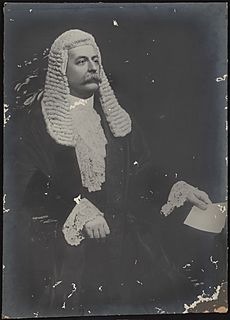Carty Salmon facts for kids
Quick facts for kids
Carty Salmon
|
|
|---|---|
 |
|
| 2nd Speaker of the Australian House of Representatives | |
| In office 23 July 1909 – 30 June 1910 |
|
| Preceded by | Frederick Holder |
| Succeeded by | Charles McDonald |
| Member of the Australian Parliament for Grampians |
|
| In office 20 February 1915 – 15 September 1917 |
|
| Preceded by | Edward Jolley |
| Succeeded by | Edmund Jowett |
| Member of the Australian Parliament for Laanecoorie |
|
| In office 29 March 1901 – 23 April 1913 |
|
| Preceded by | New seat |
| Succeeded by | Division abolished |
| Personal details | |
| Born |
Charles Carty Salmon
27 July 1860 Amherst, Victoria |
| Died | 15 September 1917 (aged 57) South Yarra, Victoria |
| Nationality | Australian |
| Political party | Protectionist (1901–09) Liberal (1909–17) Nationalist (1917) |
| Spouse | Nancy Anne Harris |
| Alma mater | University of Melbourne Edinburgh Medical School |
| Profession | Doctor |
| Signature | |
Charles Carty Salmon (born 27 July 1860 – died 15 September 1917) was an important Australian politician. He was the second Speaker of the Australian House of Representatives. This means he was like the referee for the main Australian parliament, making sure debates ran smoothly.
Carty Salmon was a doctor before he became a politician. He first served in the Victorian state parliament. Later, he was elected to the very first Australian federal parliament in 1901. He was a member of the Protectionist Party and then the Liberal Party. He served as Speaker from 1909 to 1910. He lost his seat in 1913 but came back to parliament in 1915. He passed away while still in office two years later.
Contents
Early Life and Education
Charles Carty Salmon was born in a town called Amherst, Victoria, on 27 July 1860. His parents, Frederick and Susannah, were from England. His father was a storekeeper, and his uncle ran a company that imported and made tobacco.
After finishing school at Scotch College, Melbourne, Charles worked for his father and uncle for a short time. However, he didn't enjoy these jobs. In 1886, he decided to study medicine at the University of Melbourne. While there, he also learned how to row and debate. After three years, he finished his medical training at the Edinburgh Medical School in Scotland. He also took time to travel around England and Europe.
In 1891, Carty Salmon became a registered doctor in Melbourne. He started his own medical practice in South Yarra, Victoria. He also volunteered as a surgeon for a local relief committee. This is where he met Alfred Deakin, who would later become a Prime Minister of Australia. They became lifelong friends. However, Carty Salmon soon realized that being a doctor wasn't what he wanted to do either.
Starting in Politics
Carty Salmon decided to try politics. In 1893, he won a special election (called a by-election) for a seat in the Victorian Legislative Assembly. This was the state parliament for Victoria. He ran as an independent, meaning he didn't belong to a major political party at first.
He quickly became involved in politics and supported ideas like fair working hours and rules to protect local industries. From 1899 to 1900, he served in the Victorian government. He was a minister without a specific department at first, and then he became the minister for public instruction and commissioner for trade and customs.
Federal Politics and Speaker Role
In 1901, Australia became a federation, and a new national parliament was formed. Carty Salmon was elected to the first Australian House of Representatives. He represented the area of Laanecoorie for the Protectionist Party. He held this seat until it was removed in 1913.
He was known for supporting the White Australia policy, which aimed to limit non-European immigration. He also believed in a strong national defense, but he was against forcing people to join the army (conscription). From 1904 to 1905, he was the chairman of committees in the House of Representatives. This role helps manage the work of different parliamentary committees.
In 1909, the Protectionist Party joined with another party to form the Commonwealth Liberal Party. Carty Salmon became a member of this new party. He was a strong supporter of Alfred Deakin, who became Prime Minister for the third time.
On 23 July 1909, the Speaker of the House, Sir Frederick Holder, sadly passed away while in parliament. On the very same day, Carty Salmon was chosen to be the new Speaker. He won the election with the help of Alfred Deakin.
Carty Salmon's time as Speaker was short, lasting less than a year. In the 1910 election, the Labor Party won. They then chose their own member, Charles McDonald, to be the Speaker. This was the shortest time anyone had been Speaker until 1998.
After his seat was removed in 1913, Salmon tried to get elected to the Australian Senate, but he wasn't successful. However, in 1915, he won a special election for the seat of Grampians. In 1916, he joined the new Nationalist Party.
Australian Natives' Association
Charles Carty Salmon joined the Australian Natives' Association (ANA) in 1894. This was a group that promoted Australian identity and interests. He quickly became a leader in the association and was elected its Chief President in 1898.
This was a very important time because it was the year of the referendum for Federation. Federation was when the different Australian colonies decided to join together to form one country. Because he was the head of the ANA, Carty Salmon became well-known for supporting Federation.
Personal Life and Legacy
In 1900, Carty Salmon married Nancy Anne Harris, whose father had been the Mayor of Sydney.
Carty Salmon was also a freemason, which is a member of a fraternal organization. From 1914, he was the grand master of the Grand Lodge of Victoria, which is a very high position in Freemasonry. He was also a lieutenant-colonel in the Australian Army Medical Corps and commanded a military hospital in Melbourne in 1914.
Carty Salmon passed away on 15 September 1917, at his home in South Yarra, Victoria. He was buried with special ceremonies from both the Freemasons and the military. Important people like Prime Minister Billy Hughes and the Leader of the Opposition Matthew Charlton attended his funeral.
Images for kids


